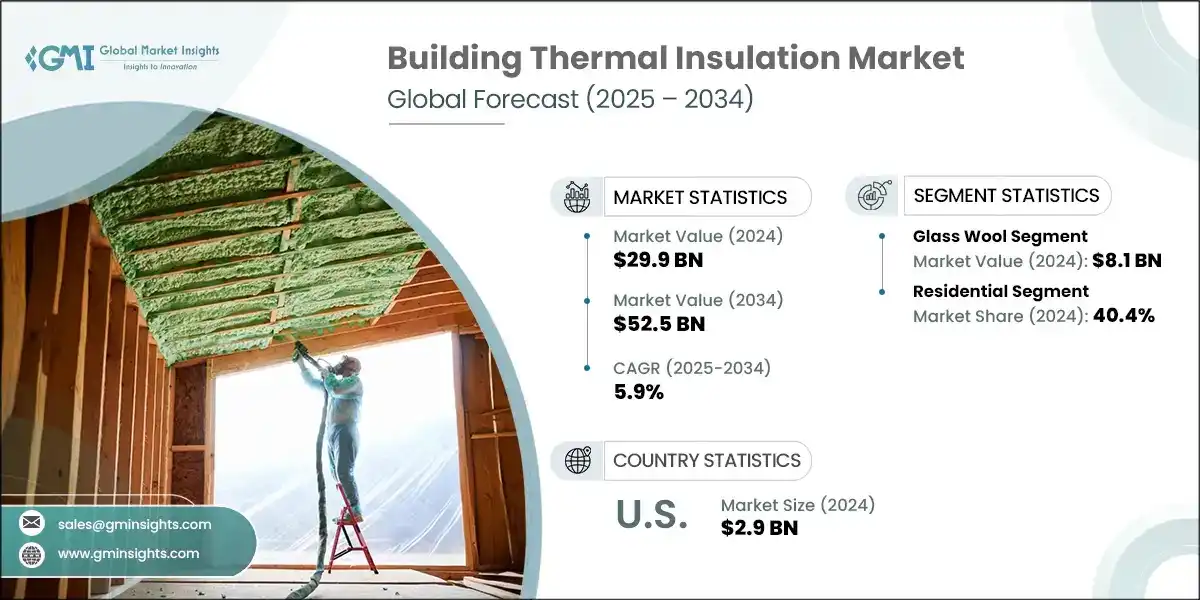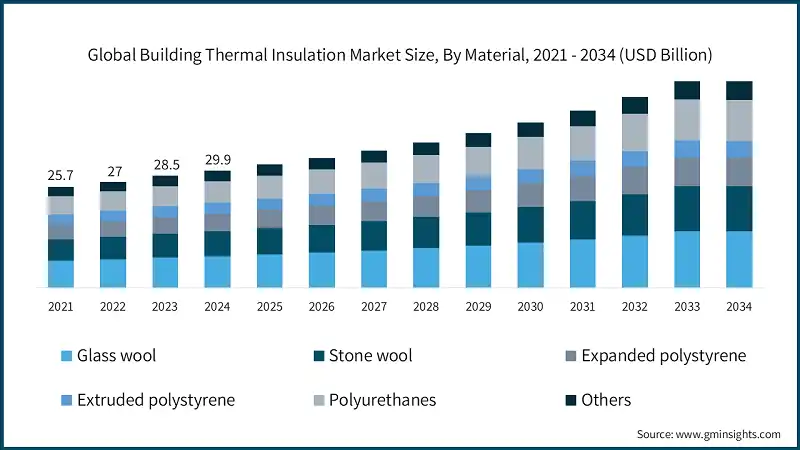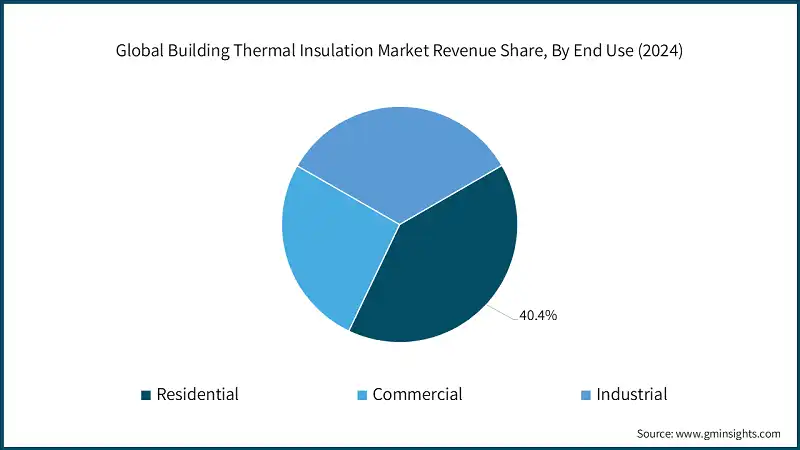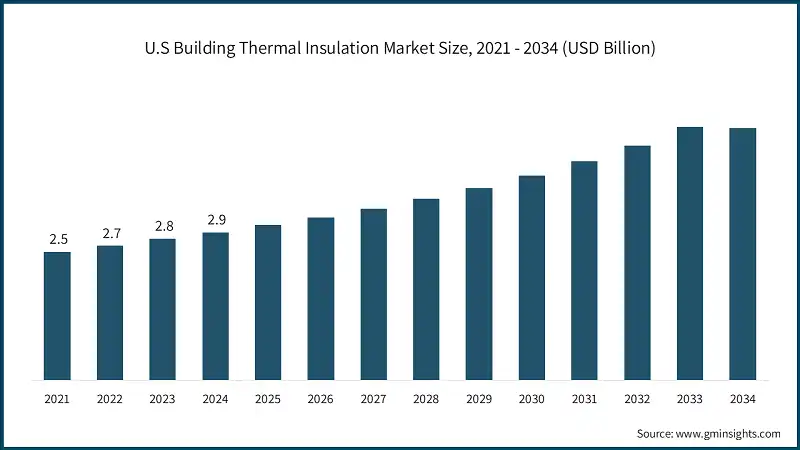Summary
Table of Content

Building Thermal Insulation Market
Get a free sample of this report
Thank you!
Your inquiry has been received. Our team will reach out to you with the required details via email. To ensure that you don't miss their response, kindly remember to check your spam folder as well!
Form submitted successfully!
Error submitting form. Please try again.

Request Sectional Data
Thank you!
Your inquiry has been received. Our team will reach out to you with the required details via email. To ensure that you don't miss their response, kindly remember to check your spam folder as well!
Form submitted successfully!
Error submitting form. Please try again.
Building Thermal Insulation Market Size
According to a recent study by Global Market Insights Inc., the global building thermal insulation market was estimated at USD 29.9 billion in 2024. The market is expected to grow from USD 31.4 billion in 2025 to USD 52.5 billion in 2034, at a CAGR of 5.9%

To get key market trends
- The building thermal insulation industry focuses on materials, systems, and methods that reduce heat transfer in residential, commercial, and industrial buildings. These solutions aim to maintain internal temperature, enhance energy efficiency, and decrease greenhouse gas emissions by minimizing heating and cooling requirements.
- Market growth is driven by increasing urbanization, infrastructure development, and growing awareness of sustainability practices in the construction industry. Government regulations and standards mandating energy efficiency measures further stimulate market demand.
- The market encompasses various insulation materials, including fiberglass, mineral wool, foam, cellulose, and reflective systems, each designed for specific building types and requirements.
- Growth is supported by expansion in the construction industry, particularly in emerging economies, and the increasing need to retrofit existing buildings for improved energy efficiency. The global emphasis on green buildings and sustainable design practices has increased demand for eco-friendly insulation materials.
- Technological advancements have introduced improved solutions such as aerogel insulation and spray foam insulation, which offer enhanced thermal resistance and simplified installation processes. The market continues to expand as both developed and developing countries focus on reducing energy costs and carbon footprints.
- Glass wool held the largest share in the market, due to its optimal combination of cost, thermal performance, and installation simplicity. The material remains a primary choice for insulation in residential and commercial buildings.
- The cost-effectiveness of glass wool enables widespread use across various applications, particularly in emerging economies where price considerations significantly influence construction material selection.
- Asia Pacific held the largest share in the global building thermal insulation market, driven by rapid urbanization, economic growth, and infrastructure development. China, India, Japan, and Southeast Asian nations have experienced significant growth in construction activities over the past decade due to rising income levels, population growth, and government urban development initiatives.
- The expansion in construction activities has created substantial demand for energy-efficient building materials, including thermal insulation products, to comply with regulations and meet consumer requirements for sustainable living spaces.
Building Thermal Insulation Market Report Attributes
| Key Takeaway | Details |
|---|---|
| Market Size & Growth | |
| Base Year | 2024 |
| Market Size in 2024 | USD 29.9 Billion |
| Forecast Period 2025 - 2034 CAGR | 5.9% |
| Market Size in 2034 | USD 52.5 Billion |
| Key Market Trends | |
| Drivers | Impact |
| Rising energy efficiency regulations | Governments worldwide are implementing stringent building codes and standards to improve energy efficiency. Thermal insulation materials provide an effective solution to reduce energy consumption for heating and cooling. |
| Growing construction and urbanization | Rapid urbanization, particularly in emerging economies, combined with infrastructure development in private and commercial construction markets, increases demand across residential, commercial, and industrial buildings. |
| Environmental concerns and sustainability initiatives | Growing awareness of climate change and commitments to sustainable building practices increase the adoption of energy-efficient insulation materials from eco-friendly sources to reduce carbon footprints. |
| Pitfalls & Challenges | Impact |
| High initial investment costs | The high initial costs of insulation materials, installation, and procurement limit broader market acceptance, especially in price-sensitive markets. |
| Availability of alternative technologies | The development of new innovative building materials and energy-saving technologies may reduce reliance on traditional thermal insulation solutions. |
| Opportunities: | Impact |
| Development of eco-friendly and recycled materials | The development and promotion of insulation products from recycled or bio-based materials present opportunities to serve eco-conscious consumers and builders. |
| Retrofitting and renovation market growth | The increasing focus on upgrading existing buildings to meet modern energy standards creates opportunities for insulation providers in the retrofit project segment. |
| Market Leaders (2024) | |
| Market Leaders |
15% market share |
| Top Players |
The collective market share in 2024 is 35% |
| Competitive Edge |
|
| Regional Insights | |
| Largest Market | Asia Pacific |
| Fastest Growing Market | Asia Pacific |
| Emerging Country | China, India, U.S, Germany |
| Future Outlook |
|
What are the growth opportunities in this market?
Building Thermal Insulation Market Trends
- The building thermal insulation industry has expanded due to increased global focus on energy efficiency and sustainable construction. Governments worldwide have implemented stringent building codes to reduce energy consumption in the construction industry, accelerating the transition toward energy efficiency.
- Energy conservation initiatives are particularly prominent in North America, Europe, and Asia-Pacific regions. The demand for building thermal insulation has increased as more buildings pursue green certifications such as LEED and BREEAM.
- Technological advancements in insulation materials have shaped market development, with manufacturers investing in research and development to create eco-friendly and high-efficiency products. These include bio-based insulations, materials with recycled content, and products with phase change properties that deliver enhanced thermal performance while minimizing environmental impact.
- Advances in nanotechnology have enabled the development of lightweight, durable insulation solutions that optimize space in construction projects. These developments align with the increasing consumer preference for sustainable building materials that improve overall building performance.
- The adoption of insulation in retrofit and renovation projects has increased, particularly in urban areas with aging building stock. Building owners and governments favor retrofitting existing structures with energy-efficient insulation to meet climate action goals and reduce utility costs associated with older, inefficient building systems.
- The market growth is driven by urbanization and infrastructure development in emerging economies, supported by increased investment across residential, commercial, and industrial sectors.
Building Thermal Insulation Market Analysis

Learn more about the key segments shaping this market
Based on the material, the market is categorized into glass wool, stone wool, expanded polystyrene, extruded polystyrene, polyurethanes, and others. The glass wool segment crossed USD 8.1 billion in 2024.
- Glass wool serves as a thermal insulator, gaining widespread adoption due to its insulation properties and cost-effectiveness. The material provides fire and sound resistance, making it valuable for residential and commercial construction projects.
- The applications of glass wool in walls, roofs, and HVAC systems drive its market demand. The expansion of construction activities globally, particularly in emerging economies seeking economical insulation solutions, has increased glass wool usage.
- Additionally, the recyclability of material and environmental certifications supports its market growth, aligning with the increasing focus on sustainable construction materials.

Learn more about the key segments shaping this market
Based on the end use, the building thermal insulation market is segmented into residential, commercial and industrial. The residential segment dominated 40.4% of the market share with USD 12.1 billion in 2024.
- The residential segment growth stems from expansion in residential construction, driven by urbanization and rising disposable income. Homebuyers and developers prioritize energy-efficient homes to minimize energy consumption and costs, increasing the demand for high-quality insulation materials.
- Government regulations on energy efficiency in residential buildings have further strengthened this demand. The retrofitting of existing homes with modern insulation solutions for improved comfort and reduced environmental impact contributes to segment growth.
- The increasing awareness of homeowners about insulation benefits - including indoor comfort, noise reduction, and long-term cost savings, continues to drive demand. The residential segment represents a key growth area in the building thermal insulation industry, supported by the increasing focus on sustainable living and green building practices.

Looking for region specific data?
The U.S. building thermal insulation market crossed USD 2.9 billion in 2024.
- The U.S. dominates the North American market due to its extensive construction industry and consistent demand for energy-efficient insulation across residential, commercial, and industrial sectors.
- Building regulations emphasizing energy conservation drive market growth, as insulation reduces heating and cooling energy consumption. Government incentives, including tax credits and LEED certification programs, promote the adoption of energy-efficient solutions.
- The U.S. serves as a hub for insulation technology development, with manufacturers producing innovative materials. Growing consumer focus on sustainability, along with the country's diverse climate zones requiring temperature management solutions, further strengthens the thermal insulation market.
Europe building thermal insulation market is expected to grow at a 6% CAGR during 2025 to 2034.
- The European market continues to expand due to heightened emphasis on sustainability and energy efficiency. The region maintains its position at the forefront of green building practices through established certification systems like BREEAM and LEED, which promote energy-efficient insulation in new construction and renovation projects.
- The European Union's Energy Performance of Buildings Directive (EPBD) mandates improved energy performance standards, increasing insulation requirements. The prevalence of aging buildings across European cities necessitates energy-efficient retrofitting initiatives.
- The market shows increased adoption of sustainable materials, including recycled cellulose, sheep wool, and hemp-based insulation products. This growth is reinforced by consumer preferences and regulatory requirements focused on reducing carbon emissions and improving energy efficiency.
Asia Pacific building thermal insulation market is expected to grow at 6.4% CAGR from 2025 to 2034.
- The Asia-Pacific market for building thermal insulation demonstrates significant growth, driven by rapid urbanization and industrial expansion. Construction activities are increasing across China, India, and Southeast Asian nations due to urban development and infrastructure projects. This expansion creates demand for insulation materials that enhance energy efficiency and reduce cooling requirements, particularly in tropical climates.
- Government regulations in China and India implementing stricter energy efficiency standards further stimulate insulation material adoption. Expanded polystyrene (EPS) and extruded polystyrene (XPS) remain preferred choices due to their cost-effectiveness and performance capabilities.
- The region also exhibits increasing demand for sustainable insulation materials, including cellulose and recycled foams, in response to environmental considerations and global sustainability initiatives.
Building Thermal Insulation Market Share
- The top companies in the building thermal insulation industry are Owens Corning, Saint-Gobain Isover, Knauf Insulation, Rockwool International, and Kingspan Group, contribute approximately 40% of the market in 2024. The major market players maintain extensive product portfolios encompassing fiberglass, mineral wool, and high-performance foams. Their established distribution networks and brand recognition enable them to serve both residential and commercial construction segments effectively.
- Rockwool International manufactures mineral wool insulation products globally. The company produces fire-rated and soundproofing insulation for residential, commercial, and industrial buildings.
- Saint-Gobain Isover, a business unit of Saint-Gobain Group, manufactures glass wool and mineral wool insulation globally for residential, commercial, and industrial applications.
- The key market players invest in sustainable and energy-efficient technologies in response to environmental requirements. Their continuous product development addresses evolving market needs, particularly regarding regulatory compliance and improved energy performance. With their presence across Europe, North America, and Asia-Pacific regions, these companies are positioned to benefit from increasing construction activity and demand for energy-efficient buildings.
Building Thermal Insulation Market Companies
Major players operating in the building thermal insulation industry are:
- Armacell
- Burnett & Co
- Firestone Building Products
- GLT Products
- Johns Manville
- Kingspan Group
- Knauf Insulation
- Mapei
- NICHIAS Corporation
- Owens Corning
- Recticel Insulation
- Rockwool International
- Saint-Gobain Isover
- Siltherm
- URSA
Johns Manville develops high-performance insulation products that meet energy efficiency standards across residential, commercial, and industrial markets. The company invests in research and development to produce sustainable insulation products, including fiberglass and foam materials, tailored to specific regional market needs.
Kingspan Group focuses on developing energy-efficient insulation and building envelope systems that comply with national and global green building standards. The company has introduced vacuum insulation panels and PIR (polyisocyanurate) insulation solutions designed for high-performance construction projects.
Knauf Insulation develops environmentally sustainable insulation materials, including glass mineral wool and foam plastics, to address evolving building regulations across regions. The company expands its global presence through acquisitions and market development in growth regions such as Asia-Pacific and North America.
Building Thermal Insulation Market News
- In April 2025, Neo Thermal Insulation partnered with Roof India Exhibition, to show the innovative range of insulation products at the event in Mumbai (India).
- In April 2025, Foli Aerogel launched lightweight aerogel insulation for outdoor applications. The technology utilizes a proprietary blend of high-performance fibers, delivers superior warmth, providing optimal insulation even in harsh weather conditions.
- In September 2024, Amacell announced the opening of new aero-gel insulation plant in India and launch of aerogel product line. The aerogel blanket technology and ArmaGel XG production line will complement Armacell’s aerogel-based product range. The product is fully compliant with ASTM C1728, aimed at enhancing the existing ArmaGel offering.
- In August 2023, Rockwool International A/S introduced a new mineral wool insulation made from recycled materials, offering better thermal performance and sustainability.
The building thermal insulation market research report includes in-depth coverage of the industry with estimates & forecasts in terms of revenue (USD Billion) and volume (Thousand Square Meters) from 2021 to 2034, for the following segments:
Market, By Material
- Glass wool
- Stone wool
- Expanded polystyrene
- Extruded polystyrene
- Polyurethanes
- Others
Market, By Form
- Blankets
- Panels
- Foam
- Others
Market, By Application
- Wall insulation
- Internal wall
- External wall
- Cavity wall
- Curtain wall
- Roof insulation
- Flat roof
- Pitch roof
- Floor/Slab
- Others
Market, By End Use
- Residential
- Commercial
- Industrial
Market, By Distribution Channel
- Direct
- Indirect
The above information is provided for the following regions and countries:
- North America
- U.S.
- Canada
- Europe
- Germany
- UK
- France
- Italy
- Spain
- Asia Pacific
- China
- India
- Japan
- Australia
- South Korea
- Latin America
- Brazil
- Mexico
- Argentina
- MEA
- South Africa
- Saudi Arabia
- UAE
Frequently Asked Question(FAQ) :
Who are the key players in the building thermal insulation market?
Key players include Armacell, Burnett & Co, Firestone Building Products, GLT Products, Johns Manville, Kingspan Group, Knauf Insulation, Mapei, NICHIAS Corporation, Owens Corning, Recticel Insulation, Rockwool International, Saint-Gobain Isover, Siltherm, URSA.
What are the upcoming trends in the building thermal insulation market?
Key trends include development of bio-based and recycled insulation materials, nanotechnology advancements for lightweight solutions, and increasing adoption in retrofit and renovation projects for energy efficiency.
Which region leads the building thermal insulation market?
The U.S. building thermal insulation market exceeded USD 2.9 billion in 2024, dominating North America with strong construction activity and steady demand for energy-efficient solutions across residential, commercial, and industrial sectors.
What is the growth outlook for Europe building thermal insulation market from 2025 to 2034?
Europe market is projected to grow at a 6% CAGR through 2034, due to stringent EU Energy Performance of Buildings Directive, aging building retrofits, and sustainable material adoption.
What was the valuation of residential end-use segment in 2024?
Residential segment held 40.4% market share and generated USD 12.1 billion in 2024, supported by urbanization and energy-efficient home construction.
How much revenue did the glass wool segment generate in 2024?
Glass wool generated USD 8.1 billion in 2024, leading the market due to its optimal combination of cost-effectiveness, thermal performance, and installation simplicity.
What is the market size of the building thermal insulation in 2024?
The market size was USD 29.9 billion in 2024, with a CAGR of 5.9% expected through 2034 driven by rising energy efficiency regulations, growing construction activities, and sustainability initiatives.
What is the projected value of the building thermal insulation market by 2034?
The building thermal insulation market is expected to reach USD 52.5 billion by 2034, propelled by green building certifications, retrofitting projects, and eco-friendly material development.


